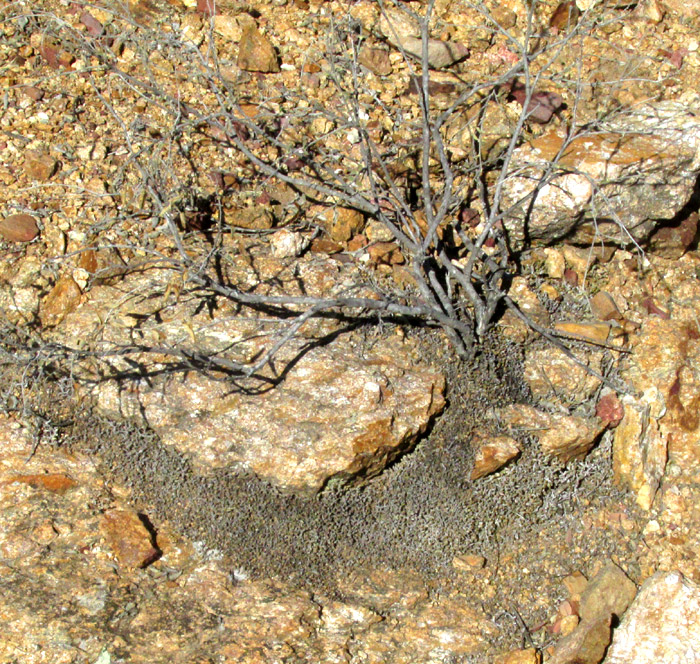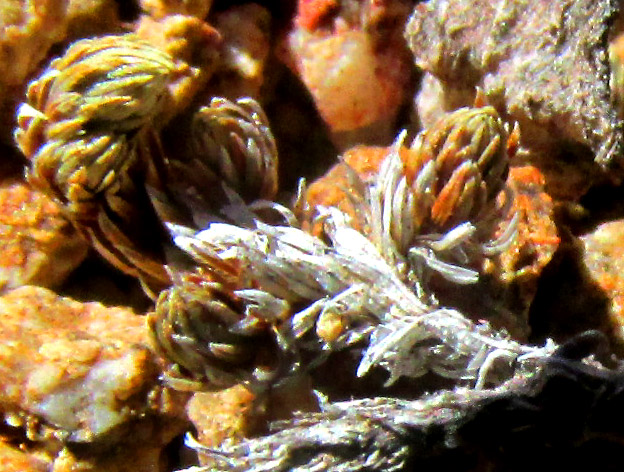Excerpts from Jim Conrad's
Naturalist Newsletter
Entry dated March 7, 2024, from notes taken about 2kms south of Higuerillas, Municipality of Cadereyta de Montes; N20.8872°, W99.7718°, elevation ~1660 meters (~5450 feet); bedrock of volcanic rhyolite; local narrow belt of vegetation constituting an extreme southern extension of the Chihuahuan Desert, Meridional Subregion; central Querétaro state, MÉXICO
WRIGHT'S SPIKEMOSS

Not the leafless bush, but rather the crumbly looking gray matter below it and at the base of the adjacent rock: That's a mat of drought-stressed spikerush, genus Selaginella, of the Spikemoss Family, the Selaginellaceae. Spikemosses, like their kin the mosses, mostly grow in moist, shady spots, not sunlight-pounded, drought-stricken (category D3 Severe Drought according to the North American Drought Monitor), desert regions like this.

The above branching stem advanced across loose gravel at the edge of the mat. Pointed, overlapping scales covering the stems are typical of spikemosses. Spore-producing fern allies known as clubmosses, genus Lycopodium, are structurally similar to our plant. However, clubmosses -- despite the "moss" in their name -- are very unrelated vascular plants allied with ferns, while our spikemoss is a bryophyte, ken to mosses. Bryophyte stems and leaves lack a pipe-like water- and nutrient-transporting vascular system; they absorb water and nutrients through their stem and leaf surfaces. Above, notice the greenish, artichoke-like budding stems at the image's top, left corner, and the dark, wiry, root-bearing rhizophores emerging from the stems, in the lower, right corner. Below you can better see the greenish budding stems.

Currently Kew's Plants of the World Online database recognizes 730 Selaginella species worldwide. The 2021 volume of the Flora del Bajío documenting Selaginella for our region of upland central Mexico says that in Mexico 80 species have been documented, 21 of which occur in our Bajío region. For identifying which of those 21 species we have here, besides the scale arrangement and root-bearing rhizophores emerging along the stem's length, field marks to note above include the leaves' general shape, their being arranged in eight ranks around their stems, their being held tightly close to the stem, their tips not ending in distinct needle-like bristles, and if their margins bear teeth or cilia, they're too small to see at our magnification.

Though experts are unclear about the differences between Selaginella roots and rhizophores, the general consensus seems to be that the part issuing from the stem is a rhizophore, and anything below where the rhizophore branches in a Y-shaped manner is a root. Above, the tiny, white, hairlike items at the tips of the image's top rhizophore look like root hairs, the part of the root absorbing water and minerals. I was surprised that root hairs formed on a root growing between loose, dry gravel particles, not in actual soil, and that the rhizophore arose on a sprout looking fairly dead.
In our Bajío region, if you have one of our 21 Selaginella species in which the scale-like leaves arise all around the stem instead of alternating from one stem side to the other, as on the Pale Spikemoss, if the leaf tips bear no needle-like bristles, leaf margins have no prominent teeth, and if the leaves themselves are held close to the stem's surface, not spreading away from the stem, you have SELAGINELLA WRIGHTII, the Wright's Spikemoss.
Wright's Spikemoss occurs on exposed or shaded limestone cliffs in the US's southeastern New Mexico and western Texas, and southward spottily throughout Mexico's uplands to Oaxaca state. In Mexico, it's found in pine forests and dry scrubland. Apparently this area's igneous rhyolite bedrock contains enough calcium to satisfy our plant's sedimentary limestone affinities.
Worldwide, since ancient times spikemosses have been used medicinally for a wide variety of conditions. Because usually they grow on rocks, in accordance with the Doctrine of Signatures, often they're regarded as effective against kidney stones and urinary tract ailments in general. Otherwise, our Wright's Spikemoss probably looks too much like other Selaginella species to warrant special mention in the literature as a traditional therapy.
For my part, Wright's Spikemoss gains a special place in my heart simply because it can cover a bare rock baking beneath unrelentingly scorching sunlight. With climate change, such exquisitely adapted organisms may be among the survivors.